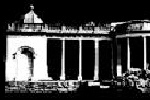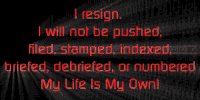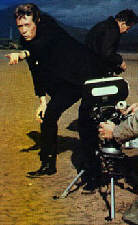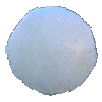  
|
Prisoner: Where am I? . .
|
. . Number Two: In the Village
|
|
Prisoner: What do you want? . .
|
. . Number Two: Information
|
|
Prisoner: Whose side are you on? . .
|
. . Number Two: That would be telling.
We want information, information, information.
|
|
Prisoner: You won't get it! . .
|
. . Number Two: By hook or by crook, we will!
|
|
Prisoner: Who are you? . .
|
. . Number Two: The new Number Two
|
|
Prisoner: Who is Number One? . .
|
. . Number Two: You are Number Six.
|
Prisoner: "I am not a number, I am a FREE MAN!"

Page #1
To quote the creator of The Prisoner:
"I believe passionately in the freedom of the individual, and The Prisoner is basically about the dehumanizing, the loss of individuality, which is happening to us all. People are the prisoners of our society. The series is a comment about life. The Prisoner idea was with me for many years before I put it together with Portmeirion and decided to do the series. The general theme of the man in isolation against authority and bureaucracy, the idea of being a rebel against suppression and stupid rules has been with me since I was able to start thinking about anything at all."
--Patrick McGoohan
Fans have taken the message further, speculating that this show is about the inferior characteristics of oneself being one's worst enemy, or the fact that we actually imprison ourselves. Or numerous other theories, ideas, postulations, discussions. . .
But before I digress, allow me to state one fact nobody should dispute: it is all this debate which has kept the show alive and made it a cult favorite. Patrick McGoohan reportedly finds it "marvelous" that the meaning is much-debated, but he'd like to know what it means if anyone figures it out.
 Each episode is a story of itself, which is not unusual, but the entire series was created to be like a novel with 17 chapters, having a definite beginning and end, even if the tv genre has rather blurred the middle section typically found in novels. What is clear, though, is the many interpretations viewers have, as mentioned above. This show works as action/suspense and also as a vehicle to stimulate intellect. Intelligence shines in the otherwise often dull medium of television.
Each episode is a story of itself, which is not unusual, but the entire series was created to be like a novel with 17 chapters, having a definite beginning and end, even if the tv genre has rather blurred the middle section typically found in novels. What is clear, though, is the many interpretations viewers have, as mentioned above. This show works as action/suspense and also as a vehicle to stimulate intellect. Intelligence shines in the otherwise often dull medium of television.
The first United Kingdom airdate for The Prisoner was on October 1, 1967 (some sources insist it was September). McGoohan originally intended for the show to be a mini-series with only seven episodes. His financier, Lew Grade, wanted 30 episodes and stated that a mere seven would not sell the series. They compromised on 17, and to this day, no more or no less have been created -- though there has been some talk of a Prisoner movie, an idea which has yet to come to cinematic fruition.
|
List of Patrick McGoohan's Original 7 Episodes:
- Arrival
- Dance of the Dead
- Checkmate
- The Chimes of Big Ben
- Free for All
-
-
-
-
-
-
-
-
-
-
- Once Upon a Time
- Fall Out
|
Episode Sequence Approved by Patrick McGoohan:
- Arrival
- Free for All
- Dance of the Dead
- Checkmate
- The Chimes of Big Ben
- Many Happy Returns
- The Schizoid Man
- The General
- A, B and C
- Living in Harmony
- It's Your Funeral
- Do Not Forsake Me, Oh My Darling
- A Change of Mind
- Hammer into Anvil
- The Girl Who was Death
- Once Upon a Time
- Fall Out
|
NOTES
- The show had its American debut in June of 1968.
- Patrick McGoohan used his real birthdate and publicity photo for his character in the The Prisoner.
- The seven original episodes are the crux of the show, obviously. The others are worth watching, though not absolutely essential to The Prisoner.
- Some of the extra ten episodes contain no (or re-used)
shots of the Village, which is a real place in Wales, called Portmeirion. The location itself serves as a resort, or hotel, and is much smaller than was depicted in the series. Visit | Virtual Portmeirion | here.
- Another much contested point is whether or not The Prisoner is a sequel to Danger Man (called Secret Agent in the USA), considered a succesful show in its time.
- McGoohan was a highly paid actor, being the number one British TV star in the 1950s to '60s.
- Patrick McGoohan was asked, twice, to play James Bond -- once before the part was offered to Sean Connery, a second time before Roger Moore took the role.
- He was in a play called The Prisoner but this was unrelated to the show.
- Living in Harmony was omitted when the show first aired in America. CBS claimed their reason for censorship was because of the portrayal of drug use. However, an episode like A, B and C being aired refutes this argument. It was most likely pulled because of its opposition to authority and dissing the law during the Vietnam era.
- Starring in, directing, producing, and writing many of the episodes, McGoohan occasionally adopted a pseudonym to reduce the number of credits to his name. One such alter ego was Joseph Serf.
Scroll right and up, please
|

Page #2
Biographical Information
I was surprised to learn that Patrick Joseph McGoohan was born in the United States! The date was March 19th, 1928. The place: Astoria, Long Island. The reported time: 4:31 a.m.
His parents, Thomas McGoohan (an Irish farmer) and Rose Fitzpatrick, married in the 1920's. They emigrated to America, seeking work, but returned to Ireland a few months after Patrick's birth. His early childhood in County Leitrim was a poor one eked out on a family farm that produced little, well, produce. Seven years after migrating back to Ireland, the family relocated to Sheffield, England.
By 1944 (following a wartime evacuation), he had left school at the age of sixteen (even though he passed the exams for admission to Oxford -- and decided not to go) to be employed by the Sheffield British Rope Company. He got his first role at a local amateur production at St. Vincent's Youth Center. However, theatre did not dominate his life for a few years to come. He worked in a bank for a couple of years, then managed a chicken farm (in Chesterfield), but he did belong to several dramatic societies during this time.
Unemployed in 1947, apparently allergic to chicken feathers, he spent six months in bed with bronchial asthma. Not yet twenty, he was accepted as a stage manager for the Sheffield Repertory Theatre, where he not only managed but worked on sets and lighting and all around the theatre, doing whatever was necessary to produce the plays. Acting wasn't the main course on his menu, not until a lead actor took ill and he stepped into the role. Before that, he did portray small parts, and learned acting basics from the director of the company, Geoffrey Ost. Patrick became a leading man with this company, which produced 24 plays a year. Of all the various shows, including works by Shakespeare, Coward, Chekhov and Shaw, he favored the lighter Shakespearean roles. This Petruchio estimates he appeared in at least 200 plays during his early Rep days.
Future wife Joan Drummond met him here. They were married May 19, 1951, between a rehearsal of The Taming of the Shrew and a performance of The Rivals. 1952 witnessed the birth of daughter Catherine. As his personal life expanded along with the size of his family (he and his wife were to eventually have three daughters), so did his career move forward in the 50's. After performing in hundreds of small and large theatrical productions, McGoohan's film debut was in 1955 in Passage Home, a bit part which led to work in other films. A five year contract with the Rank Organization in 1957 helped him on his path to stardom.
He returned to stage work, and won the Best Televison Actor of the Year Award for a role in The Greatest Man in the World, in which he portrayed the first man on the moon, and then Patrick signed a contract with Disney. Two of my favorite Disney films resulted from this working relationship: Dr. Syn, Alias the Scarecrow (also called The Scarecrow of Romney Marsh for a three-part broadcast on American telly) and The Three Lives of Thomasina.
 Lew Grade, an ITC (The Independent Television Corporation) chairman who later financed The Prisoner, had seen Patrick's tv work (in Clifford Odets' The Big Knife -- 1959) and cast him as secret agent John Drake in Danger Man. To quote Lew Grade regarding his choice of actor for John Drake: "It was the way he [Patrick McGoohan, of course!] moved. He moved like a panther -- firm and decisive." The half-hour episodes were about John Drake's work for NATO, as a special security agent travelling the world to solve problems for free world governments. This character relied on wits and intelligence, rather than a gun. Also, he was very un-James Bond and did not pursue women. Nor did he pursue the role of Bond, turning it down. The success of Danger Man (Secret Agent in the USA, now expanded to an hour and having John Drake work for England rather than NATO) allowed the British to break into the American television market for the first time.
Lew Grade, an ITC (The Independent Television Corporation) chairman who later financed The Prisoner, had seen Patrick's tv work (in Clifford Odets' The Big Knife -- 1959) and cast him as secret agent John Drake in Danger Man. To quote Lew Grade regarding his choice of actor for John Drake: "It was the way he [Patrick McGoohan, of course!] moved. He moved like a panther -- firm and decisive." The half-hour episodes were about John Drake's work for NATO, as a special security agent travelling the world to solve problems for free world governments. This character relied on wits and intelligence, rather than a gun. Also, he was very un-James Bond and did not pursue women. Nor did he pursue the role of Bond, turning it down. The success of Danger Man (Secret Agent in the USA, now expanded to an hour and having John Drake work for England rather than NATO) allowed the British to break into the American television market for the first time.
An episode called A View from the Villa was filmed at Portmeirion, Wales. The location caught Patrick McGoohan's imagination so much that the rest is history, as they say.
Patrick turned in his resignation right after the first episode of the fourth year, Koroshi was filmed. His own production company was set up to create his new interest, The Prisoner, in 1966. Noted author and script editor, George Markstein, collaborated to sell the show to the aforementioned Lew Grade. Even though spy stories had become all the rage back in 1964, The Prisoner was a risky venture, being the most costly television production of its day. While they did negotiate about the number of episodes, Patrick nonetheless had enough clout to have free rein over his new show.
"The Prisoner started production in 1966. I had directed before that. I had directed in the theatre, and I'd done some writing. And, of course, during the making of Secret Agent, I directed some of those. I liked the total involvement. I'm not very happy just doing peripheral tasks. So that one is working as near as one can get to 24 hours a day. I like that, the feeling of achievment. The working with new ideas, I think that's wonderful. But one can only do it in spurts or you burn out."
--Patrick McGoohan
Thirteen of the seventeen episodes were produced when McGoohan took time off to act in Ice Station Zebra (1967) with Ernest Borgnine and Rock Hudson. The final four were shot in a very short span of time. After the airing of the last episode, Fallout, the McGoohan family took a vacation in Switzerland. Rest was required, but Patrick also wanted to escape the reaction to the end of the show. Many disliked the surreal allegories of the episode, some quite violently opposed to it. The series was controversial from beginning to end.
It has been reported he wrote a script for a Prisoner film, but apparently his screenplay was rejected and reworked, and the last I heard, the movie was set to be made in 1997. To date, this has not happened, but this unprojected project lives up to its ancestor, creating much debate about what it will be like, who will be in it. . . theories, ideas, postulations, discussions. . .

|
|
FILMS
1954
Passage Home
The Dam Busters
1955
I am a Camera
The Dark Avenger
1956
Zarak
High Tide at Noon
1957
The Gypsy and the Gentleman
Hell Drivers
1958
Nor the Moon by Night
1961
All Night Long
Two Living, One Dead
1962
The Quare Fellow
No Life for Ruth
1963
Dr. Syn, Alias the Scarecrow
The Three Lives of Thomasina
1967
Ice Station Zebra
1970
The Moonshine War
1971
Mary, Queen of Scots
1973
Catch My Soul (director only)
1975
Genio, Due Compari, Un Pollo
(UK: The Genius)
1976
Silver Streak
1978
Brass Target
1979
Escape from Alcatraz
1980
The Hard Way
1981
Scanners
1983
Kings & Desperate Men (shot in 1978)
1985
Baby: Secret of a Lost Legend
1987
Trespasses (shot in 1983)
1995
Braveheart
1996
The Phantom
A Time to Kill
1997
Hysteria
|
TV: Movies, Plays, Series, etc
1954
The Vise: Gift From Heaven
You Are There: The Fall of Parnell
1955
All My Sons
1956
Moby Dick
The Makepeace Saga: Ruthless Destiny
1957
Disturbance
The Little World
The Third Miracle
Rendezvous (3 episodes)
1958
This Day in Fear
Rest in Violence
1959
Brand (Best British Actor Award)
The Big Knife
The Iron Harp
Terminus Number One
1960
The Greatest Man in the World
1960-62
Danger Man (1st series, 39 episodes)
1961
A Dead Secret
1962
The Prisoner (unrelated tv movie)
Shadow of a Pale Horse
1964-66
Danger Man (US: Secret Agent)
:(2nd & 3rd series, 32 & 13 episodes)
1967
The Prisoner (17 episodes)
1968
Danger Man Special "Koroshi"
Journey Into Darkness: The New People (introducer)
Paper Dolls (introducer)
1974
Columbo: By Dawn's Early Light (Emmy)
1975
Columbo: Identity Crisis (also directing)
1976
Columbo: Last Salute to the Commodore (director only)
1977
The Man in the Iron Mask
Rafferty (13 episodes)
1985
Jamaica Inn
Three Sovereigns for Sarah
1986
Of Pure Blood
1987
Murder, She Wrote (titles unknown)
1990
The Best of Friends
Columbo: Agenda for Murder (also directing) (Emmy)
|
STAGE
(incomplete listing)
1951
The Taming of a Shrew (Sheffield)
The Rivals (Sheffield)
1953
Serious Charge (London)
1954
Moby Dick (London)
1955
Ring for Cathy (London)
1959
Brand (Hammersmith)
1985
Pack of Lies (Broadway)
LITERARY MISC
This actor has written:
screenplays,
poetry,
(and reportedly) a novel
|

| Two/Words (you are here) |
| Resign | Arrive | Post Office/Info/Disclaim | Map of your Village/What is The Prisoner? | One/Images | Two/Words | Links |
06.06.06

|




 Each episode is a story of itself, which is not unusual, but the entire series was created to be like a novel with 17 chapters, having a definite beginning and end, even if the tv genre has rather blurred the middle section typically found in novels. What is clear, though, is the many interpretations viewers have, as mentioned above. This show works as action/suspense and also as a vehicle to stimulate intellect. Intelligence shines in the otherwise often dull medium of television.
Each episode is a story of itself, which is not unusual, but the entire series was created to be like a novel with 17 chapters, having a definite beginning and end, even if the tv genre has rather blurred the middle section typically found in novels. What is clear, though, is the many interpretations viewers have, as mentioned above. This show works as action/suspense and also as a vehicle to stimulate intellect. Intelligence shines in the otherwise often dull medium of television.
 Lew Grade, an ITC (The Independent Television Corporation) chairman who later financed The Prisoner, had seen Patrick's tv work (in Clifford Odets' The Big Knife -- 1959) and cast him as secret agent John Drake in Danger Man. To quote Lew Grade regarding his choice of actor for John Drake: "It was the way he [Patrick McGoohan, of course!] moved. He moved like a panther -- firm and decisive." The half-hour episodes were about John Drake's work for NATO, as a special security agent travelling the world to solve problems for free world governments. This character relied on wits and intelligence, rather than a gun. Also, he was very un-James Bond and did not pursue women. Nor did he pursue the role of Bond, turning it down. The success of Danger Man (Secret Agent in the USA, now expanded to an hour and having John Drake work for England rather than NATO) allowed the British to break into the American television market for the first time.
Lew Grade, an ITC (The Independent Television Corporation) chairman who later financed The Prisoner, had seen Patrick's tv work (in Clifford Odets' The Big Knife -- 1959) and cast him as secret agent John Drake in Danger Man. To quote Lew Grade regarding his choice of actor for John Drake: "It was the way he [Patrick McGoohan, of course!] moved. He moved like a panther -- firm and decisive." The half-hour episodes were about John Drake's work for NATO, as a special security agent travelling the world to solve problems for free world governments. This character relied on wits and intelligence, rather than a gun. Also, he was very un-James Bond and did not pursue women. Nor did he pursue the role of Bond, turning it down. The success of Danger Man (Secret Agent in the USA, now expanded to an hour and having John Drake work for England rather than NATO) allowed the British to break into the American television market for the first time.